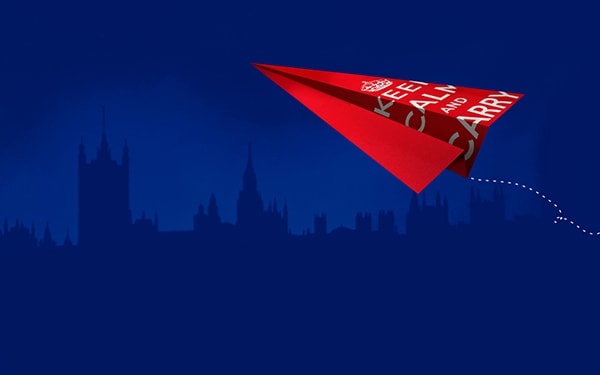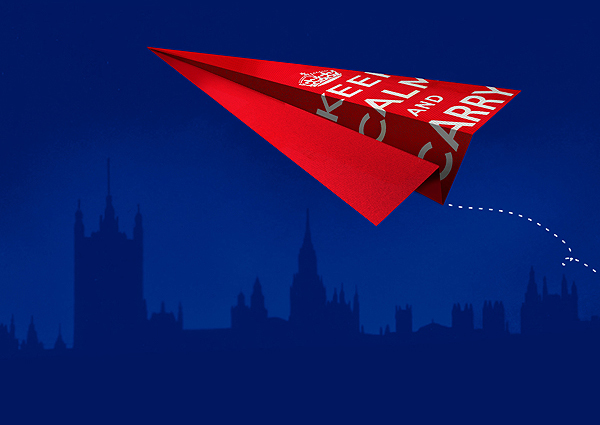
I can pinpoint the moment when I realized that what had seemed a typically, somewhat insufferably, English phenomenon had gone completely and inescapably global. I was going into the flagship Warsaw branch of the Polish department store Empik and there, just past the revolving doors, was a collection of notebooks, mouse pads, diaries and the like, featuring a familiar English sans serif font, white on red, topped with the crown above the legend, in English:
AND
CARRY ON
In the British general election of May 2015, thirty-seven percent of registered voters who bothered to turn out voted for austerity. Given that the Conservative-Liberal Democrat government had, for the previous five years, been quite dramatic in the sweep and scale of its policies, perhaps even the most radical government since Thatcher, there’s no question of what was being voted for. In education, tuition fees were put up by 300 percent; arts funding was decimated. The Education Maintenance Allowance that kept many working-class children in further education was abolished. In the National Health Service, a Health and Social Care Bill was introduced that opened up most of the NHS to private companies; benefit cuts and punitive benefit sanctions led to millions using food banks. The privatization of the railways was reinforced, and the banks nationalized at the height of the financial crisis were allowed to continue much as before, albeit lending somewhat less.
Although the vote of May 2015 was not some Thatcher-era swell of Tory support, something in this austerity agenda nonetheless struck a chord with people. At the same time Labour, under the hapless leadership of Edward Miliband, offered no serious opposition to austerity as either concept or policy, preferring instead the comically innocuous criticism that the carve-up of the welfare state’s few remnants went “too far, too fast.”
What opposition did emerge during this time—particularly after a brief flurry of protest in 2011 collapsed—was deeply indebted to a nostalgic rhetoric of a former period of austerity. The filmmaker Ken Loach released a documentary about the last era of “austerity,” The Spirit of ’45. At the same time, Loach was involved in the foundation of a new left-wing political party, Left Unity, seemingly set on the rock of that spirit. But “Austerity Britain,” the period roughly from the 1940s until around 1955, when rationing was finally lifted by a Conservative government, is the direct opposite of “Austerity Britain” Mark Two, the period from 2009-10 until the present. This most recent austerity has nonetheless been overlaid with the imagery of that earlier era. At times this has been so pervasive that it felt as if parts of the country began to resemble a strange, dreamlike reconstruction of the 1940s and 1950s, reassembled in the wrong order.
It is important to record that the “Keep Calm and Carry On” poster was never mass-produced until 2008. It is a historical object of a very peculiar sort. It was designed for the Ministry of Information in 1939, but the poster’s “official website,” which sells a variety of Keep-Calm-and-Carry-On tat, mentions that it never became an official propaganda poster. Rather, only a handful had been printed on a test basis. The specific purpose of the poster was to “stiffen resolve” in the event of a Nazi invasion, and it was one in a set of three. There were two others in the series, which followed the exact same design principles—a slogan in a sans serif font with resemblances to (but not, in fact) Gill Sans, centered on a block-color background, with the crown above. The others were:
YOUR CHEERFULNESS
YOUR RESOLUTION
WILL BRING US VICTORY
IN PERIL
DEFEND IT
WITH ALL
YOUR MIGHT
Of the three proposals, “Keep Calm and Carry On” was discarded after the test printing, and it never found its way to public display. Possibly, this was because it was considered less appropriate to the conditions of the Blitz than to the mass panic expected in the event of a German ground invasion. One of those few test printings of the poster was found in amongst a consignment of secondhand books bought at auction by Barter Books in Alnwick, Northumberland, who then produced the first reproductions.
Initially sold in London by the shop at the Victoria and Albert Museum, it became a middlebrow staple when the recession, initially merely the slightly euphemistic “credit crunch,” hit. Through this poster, the way to display one’s commitment to the new austerity regime was to buy more consumer goods, albeit with a less garish aesthetic than was customary during the boom.
Even during the height of the boom, “1940” and “1945” were “obsessive repetitions,” clung to as a means of not thinking about other aspects of recent British history – most obviously, its Empire.
By 2009, when it had first become hugely popular, it seemed to respond to a particularly English malaise, one connected directly with the way Britain reacted to the credit crunch and the banking crash. From this moment of crisis, it tapped into an already established narrative about Britain’s “finest hour”—the aerial Battle of Britain in 1940-41—when it was the only country left fighting the Third Reich. This was a moment of entirely indisputable—and apparently uncomplicated—national heroism, one which Britain has clung to through thick and thin. Even during the height of the boom, as the critical theorist Paul Gilroy spotted in his 2004 book After Empire, the Blitz and the Victory were frequently invoked, made necessary by “the need to get back to the place or moment before the country lost its moral and cultural bearings.” “1940” and “1945” were “obsessive repetitions,” “anxious and melancholic,” morbid fetishes, clung to as a means of not thinking about other aspects of recent British history—most obviously, its Empire. This has only intensified since the financial crisis began.
The “Blitz spirit” has been exploited by politicians largely since 1979. When Thatcherites and Blairites spoke of “hard choices” and “muddling through,” they often evoked the memories of 1941. It served to legitimate regimes which constantly argued that, despite appearances to the contrary, resources were scarce and there wasn’t enough money to go around; the most persuasive way of explaining why someone (else) was inevitably going to suffer. Ironically, however, this rhetoric of sacrifice was often combined with a demand that the consumers enrich themselves—buy their house, get a new car, make something of themselves, “aspire.”
Thus, by 2007-08, when the “end to boom and bust” promised by Gordon Brown appeared to be more than abortive (despite the success of his very 1940s alternative of nationalizing the banks and thus “saving capitalism”), the image appeared for the first time. It’s worth noting that shortly after this point, a brief series of protests in 2009-11 were being policed in increasingly ferocious ways. The authorities were allowed to utilize the apparatus of security and surveillance and the proliferation of “prevention of terrorism” laws set up under the New Labour governments of 1997-2010 to combat any signal of dissent. In this context the poster became ever more ubiquitous, and peculiarly, after 2011, it began to be used in what few protests remained, in an only mildly subverted form.
The “Keep Calm and Carry On” poster seemed to embody all the contradictions produced by a consumption economy attempting to adapt itself to thrift.
The “Keep Calm and Carry On” poster seemed to embody all the contradictions produced by a consumption economy attempting to adapt itself to thrift, and to normalize surveillance and security through an ironic, depoliticized aesthetic. Apparently out of nowhere, this image—combining bare, faintly modernist typography with the consoling logo of the Crown and a similarly reassuring message—spread everywhere.
The power of “Keep Calm and Carry On” comes from a yearning for an actual or imaginary English patrician attitude of stiff upper lips and muddling through. This is, however, something that largely survives only in the popular imaginary, in a country devoted to services and consumption, and where elections are given to sudden, mawkish outpourings of sentiment. The poster isn’t just a case of the return of the repressed, it is a nostalgia for the state of being repressed—solid, stoic, public-spirited, as opposed to the depoliticized, hysterical and privatized reality of Britain over the last thirty years.
It is both reassuring and flattering, implying a virtuous (if highly self-aware) consumer stoicism. Of course, in the end, it’s a bit of a joke: you don’t really think your pay cut or your children’s inability to buy a house, or the fact that someone somewhere else has been made homeless because of the bedroom tax, or lost their benefit, or worked on a zero-hours contract, is really comparable to the Blitz—but it’s all a bit of fun, isn’t it?
I first noticed its ubiquity in the winter of 2009, when the poster appeared in dozens of windows in affluent London districts during the prolonged snow and the attendant breakdown of National Rail; the implied message about hardiness in the face of adversity and the Blitz spirit looked rather absurd in the context of a dusting of snow crippling the railway system. The poster seemed to exemplify a design phenomenon that had slowly crept up on us in the last few years to the point where it became unavoidable. It’s best described as austerity nostalgia. This aesthetic took the form of a nostalgia for the kind of public modernism that, rightly or wrongly, was seen to have characterized the period from the 1930s to the early ’70s; it could just as easily exemplify a more straightforwardly conservative longing for security and stability in the face of hard times.
The poster is an example of the phenomenon given a capsule definition by Douglas Coupland in 1991: “Legislated Nostalgia,” that is, “to force a body of people to have memories they do not actually possess.”
Unlike many forms of nostalgia, the memory invoked by the “Keep Calm and Carry On” poster is not based on lived experience. Most of those who have bought this poster, or worn the various bags, T-shirts and other memorabilia based upon it, were probably born in the 1970s or ’80s. They have no memory whatsoever of the kind of benevolent statism the slogan purports to exemplify. In that sense, the poster is an example of the phenomenon given a capsule definition by Douglas Coupland in 1991: “Legislated Nostalgia,” that is, “to force a body of people to have memories they do not actually possess.”
In April 2009, another series of posters appeared on British streets, this time on behalf of the police. Based ostentatiously on “Keep Calm,” they share the same centered design and humanist sans serifs, only replacing the crown with the police badge. The text consists of three slogans, inspired by particular clichés used by the police in the popular imagination, albeit in one case with a decidedly sinister twist;
TO GIVE
YOU
A GOOD
TALKING TO;
YOU SAY
MAY
BE TAKEN DOWN
AND USED AS
EVIDENCE;
NOT
TO REMAIN SILENT.
ON HOW
CRIMINALS
PAY BACK
The advertisement explains:
To witness an instance of Community Payback, as I did in 2009 on a Greenwich council estate, is an alarming experience—a score of downcast black youth, being led by a similarly orange-jacketed overseer to pick up rubbish in an area where the council infrequently collected. It is a spectacular method of punishment intended to be watched and, it would seem, enjoyed. The Community, meanwhile, on this weekday morning, were conspicuous by their absence, so that this was a display without an audience.
Adapted with permission from The Ministry of Nostalgia: Consuming Austerity, by Owen Hatherley, © 2016 Verso Books. All rights reserved.
